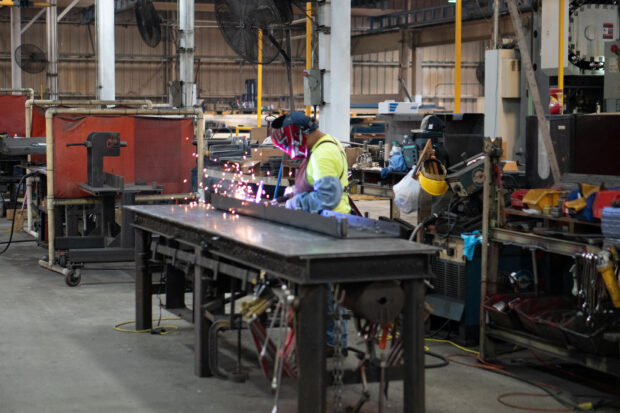
Julio Ventura welds a screed bottom for a commercial class road paver at the Calder Brothers factory in Taylors, South Carolina, U.S., in this handout picture taken July 18, 2021. Brandon Granger/Calder Brothers Corp/Handout via REUTERS/File photo
WASHINGTON – U.S. business activity picked up in January and inflation appeared to abate, with a measure of prices charged by companies for their products falling to the lowest level in more than 3-1/2 years, suggesting that the economy kicked off 2024 on a strong note.
S&P Global said on Wednesday that its flash U.S. Composite PMI Output Index, which tracks the manufacturing and services sectors, increased to 52.3 this month, the highest level since last June. The rise from 50.9 in December was driven by gains in both services and manufacturing activity.
A reading above 50 indicates expansion in the private sector. The survey‘s flash manufacturing PMI rebounded to a
15-month high of 50.3 from 47.9 in December. Its flash services sector PMI climbed to 52.9, the highest reading since last June, from 51.4 in the prior month.
The higher composite reading bolsters economists’ predictions that the economy will continue to grow this year, although at a moderate pace. Receding inflation in the survey also supports expectations that the Federal Reserve will start cutting interest rates sometime in the first half of 2024.
Delays in raw material deliveries
But companies also noted rising delays getting materials, which could put upward pressure on raw material prices.
The delays were attributed to “challenging trucking conditions due to storms and transportation delays.” S&P Global said manufacturing lead times lengthened for the first time in more than a year and by the most since October 2022.
Attacks on shipping lines by Iran-aligned Houthi militants in the Red Sea and a drought in the Panama Canal also pose an upside risk to inflation.
“With the survey indicating that supply delays have intensified while labor markets remain tight, cost pressures will need to be monitored closely in the coming months, but for now the survey send a clear and welcome message of resilient economic growth and sharply waning inflation,” said S&P Global Market Intelligence chief business economist Chris Williamson.
GDP growth estimates
The government’s first estimate of gross domestic product for the fourth quarter on Thursday is likely to show the economy growing at a 2 percent annualized rate, according to a Reuters survey of economists. The economy expanded at a 4.9 percent pace in the third quarter. The U.S. central bank has raised its policy rate by 525 basis points to the current 5.25 percent-5.5 percent range since March 2022.
The survey‘s flash composite new orders index also rose to a seven-month high of 52.2 in January from 51.2 in December. Prices paid by businesses for inputs increased at a moderate pace. Businesses raised prices for their products and services at a slower rate, with the output prices gauge falling to 51.7, the lowest reading since May 2020, from 54.8 in December.
Private sector employment continued to grow, though at a slower rate. Companies reported increasing recruitment to meet “increased business requirements and the hiring of skilled workers for long-held vacancies,” but also noted that “hiring was often constrained by labor shortages.”